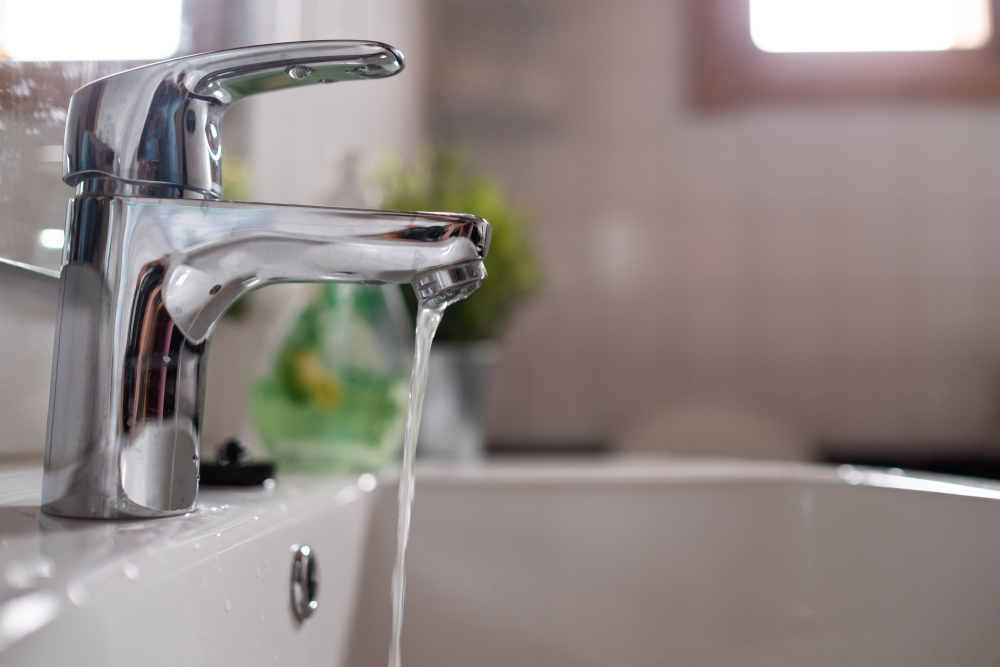Common Causes of Low Water Pressure
Low water pressure can make everyday tasks like washing dishes, doing laundry, or taking a shower frustrating. Fortunately, identifying the causes of low water pressure is the first step toward finding a solution.
Several factors can contribute to low water pressure in your home. Let’s take a closer look at each of these factors:
1. Clogged Pipes and Mineral Buildup
One of the most common reasons for low water pressure is clogged pipes. Over time, mineral deposits can accumulate inside your plumbing, gradually restricting water flow. This is especially common in areas with hard water, where minerals like calcium and magnesium are abundant. The mineral buildup clogs pipes and can drastically reduce water pressure throughout your home. Fortunately, you can address the problem with routine drain cleaning and prevent future issues with a water softener installation.
Older galvanized steel pipes are also particularly susceptible to clogs. As these pipes age, they can corrode from the inside, adding to the problem of mineral buildup. If you live in an older home with galvanized pipes, it may be necessary to replace the aging pipes with newer materials like copper or PVC.
2. Faulty Pressure Regulator
A pressure regulator is a valve that ensures your home’s water pressure stays within a safe and consistent range. If you have a broken or failing pressure regulator, you might notice your water pressure suddenly drop or spike.
A faulty pressure regulator is a common cause of low water pressure, and a simple test with a water pressure gauge can help determine if this is the problem. If the gauge shows a pressure reading below normal levels, it may be time to replace the regulator. A plumber can install a new pressure regulator to restore proper water pressure in your home.
3. Leaking Pipes
Leaks are another common cause of low water pressure. When water is escaping from your plumbing pipes through a leak, less water makes it to your faucets, resulting in reduced water flow. Leaks can occur in any part of your home’s piping system, from main water lines to branch lines that serve specific fixtures.
Keep an eye out for signs of leaking pipes, such as damp spots on walls or ceilings, unexplained increases in your water bill, mold growth, or the sound of running water when all fixtures are turned off. If you notice any of these problems, call a qualified professional for a plumbing repair right away.
4. Partially Closed Valves
Sometimes, the solution to low water pressure is simpler than you might think. Check your main shut-off valve and water meter valve to ensure they’re fully open. These valves control the water flow into your home, and if they’re partially closed, they can severely restrict water flow.
It’s not uncommon for these valves to be accidentally left partially closed after plumbing repairs or maintenance. A quick inspection and adjustment could potentially restore proper water pressure to your home.
5. Municipal Water Supply Issues
If your entire neighborhood seems to be experiencing low water pressure, the problem could be with your municipal water supply. High demand or maintenance work on the main city supply pipe can temporarily affect your home’s water pressure. Contact your water supply company to inquire about any ongoing issues in your area.
6. Clogged Fixtures
In some cases, low water pressure might be isolated to specific fixtures rather than affecting your entire home. Shower heads, faucet aerators, and other plumbing fixtures can become clogged with mineral deposits over time, restricting water flow.
Regularly cleaning or replacing these fixtures can help maintain proper water flow and pressure. For shower heads, soaking them in vinegar can often dissolve mineral buildup and restore normal function.
7. Outdated Plumbing System
If your home is older, its entire piping system might be due for an upgrade. Older plumbing systems, especially those with galvanized steel pipes, can develop numerous issues over time that contribute to poor water pressure. Corrosion, pipe narrowing, and an accumulation of years of mineral buildup can all play a part. Upgrading to modern copper pipes or PEX tubing can significantly improve your home’s water pressure and overall plumbing performance.
8. Problems With Your Water Heater
For issues specifically related to hot water pressure, your water heater might be the source of the problem. Sediment buildup in the tank can restrict water flow, leading to reduced pressure in your hot water lines. Regular maintenance of your water heater, including flushing the tank annually, can help prevent these issues.
Call the Professionals at GEI to Restore Water Pressure
While some causes of low water pressure can be addressed by homeowners, many require the expertise of a professional plumber. If you’ve tried basic troubleshooting and still can’t identify or resolve the issue, it’s time to seek help.
GEI Plumbing Services specializes in diagnosing and fixing a wide range of plumbing issues, including low water pressure problems. Our experienced technicians can quickly identify the root cause of your water pressure woes and implement effective solutions. Contact us today to schedule a water line service and get your water flowing again.


